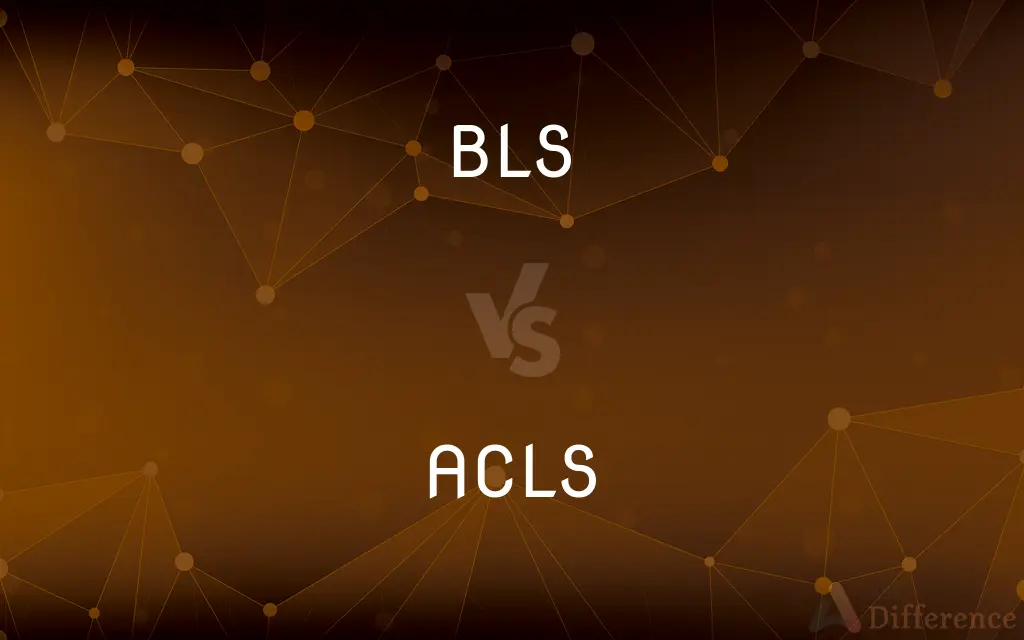BLS vs. ACLS — What's the Difference?
By Tayyaba Rehman — Published on January 25, 2024
BLS (Basic Life Support) is a level of medical care used for victims of life-threatening illnesses or injuries until they can be given full medical care. ACLS (Advanced Cardiac Life Support) is a set of clinical interventions for the urgent treatments.

Difference Between BLS and ACLS
Table of Contents
ADVERTISEMENT
Key Differences
BLS is the fundamental level of medical support, emphasizing the initial assessment and basic lifesaving techniques, such as CPR (Cardiopulmonary Resuscitation) and AED (Automated External Defibrillator) use. It's aimed at stabilizing patients in critical conditions. In contrast, ACLS involves more advanced medical procedures and requires medical knowledge. ACLS includes the management of airways, initiation of IVs, reading and interpreting electrocardiograms, and the application of emergency medications.
Training in BLS is essential for healthcare professionals, but it's also accessible to the general public. BLS skills are foundational for anyone who may respond to a cardiac or respiratory emergency. On the other hand, ACLS certification is typically pursued by healthcare professionals like nurses, paramedics, and doctors who need to provide advanced emergency medical care.
BLS certification focuses on skills like recognizing emergencies, performing effective chest compressions, delivering ventilations, and using an AED. ACLS certification requires a deeper understanding of complex cardiac conditions, the appropriate interventions, and the coordination of a multi-disciplinary response to medical emergencies.
The scope of BLS is generally confined to the initial and basic emergency care procedures, which are critical in the chain of survival in emergencies like cardiac arrest. ACLS encompasses a broader range of medical interventions and decision-making skills that are critical in a hospital setting or among advanced emergency medical responders.
Comparison Chart
Focus
Basic life-saving interventions
Advanced cardiac and life-support techniques
ADVERTISEMENT
Training Audience
Healthcare professionals and the general public
Healthcare professionals with medical background
Skills Taught
CPR, AED use, basic emergency response
Advanced airway management, ECG interpretation, emergency pharmacology
Certification Level
Basic
Advanced
Typical Responders
First responders, bystanders
Physicians, nurses, paramedics
Compare with Definitions
BLS
AED Use
In BLS training, I learned how to use an Automated External Defibrillator.
ACLS
ECG Interpretation
In ACLS training, medical professionals learn to interpret electrocardiograms.
BLS
General Public
BLS courses are available for anyone interested in learning lifesaving skills.
ACLS
Cardiac Arrest Management
ACLS certification covers the management of cardiac arrests.
BLS
Emergency Care
BLS training includes basic emergency care techniques.
ACLS
Advanced Medical Care
ACLS involves advanced techniques for handling cardiac emergencies.
BLS
First Response
BLS is crucial for first responders at the scene of an emergency.
ACLS
Healthcare Professionals
As a nurse, I am required to be ACLS certified.
BLS
CPR Training
As a lifeguard, I'm certified in BLS for CPR administration.
ACLS
Emergency Pharmacology
ACLS training includes the use of emergency medications in critical care.
Common Curiosities
Who should take BLS training?
BLS training is recommended for both healthcare professionals and the general public.
Can BLS training be done online?
Basic theoretical components can be done online, but hands-on practice is also essential.
What does ACLS stand for?
ACLS stands for Advanced Cardiac Life Support.
What are the prerequisites for ACLS certification?
A current BLS certification and some medical knowledge are usually prerequisites for ACLS.
What does BLS stand for?
BLS stands for Basic Life Support.
Is ACLS higher than BLS?
Yes, ACLS is a more advanced level of training than BLS.
Is CPR included in BLS training?
Yes, CPR is a fundamental part of BLS training.
Can anyone enroll in ACLS training?
ACLS is usually intended for healthcare professionals with a medical background.
Is AED use taught in both BLS and ACLS?
Yes, AED use is taught in both BLS and ACLS courses.
Do nurses need ACLS certification?
Many nurses, especially those in critical care or emergency departments, need ACLS certification.
How often do you need to renew BLS certification?
BLS certification typically needs to be renewed every two years.
What is the difference in cost between BLS and ACLS certification?
ACLS certification is generally more expensive due to its advanced nature.
Are BLS and ACLS certifications recognized internationally?
They are widely recognized, but certification requirements may vary by country.
What skills are covered in ACLS training?
ACLS covers advanced skills like airway management, ECG interpretation, and emergency pharmacology.
Can a layperson take ACLS training?
While possible, ACLS training is designed for those with a healthcare background.
Share Your Discovery

Previous Comparison
Qualcomm Snapdragon vs. Mediatek Helio
Next Comparison
Cisco Packet Tracer vs. GNS3Author Spotlight
Written by
Tayyaba RehmanTayyaba Rehman is a distinguished writer, currently serving as a primary contributor to askdifference.com. As a researcher in semantics and etymology, Tayyaba's passion for the complexity of languages and their distinctions has found a perfect home on the platform. Tayyaba delves into the intricacies of language, distinguishing between commonly confused words and phrases, thereby providing clarity for readers worldwide.
















































